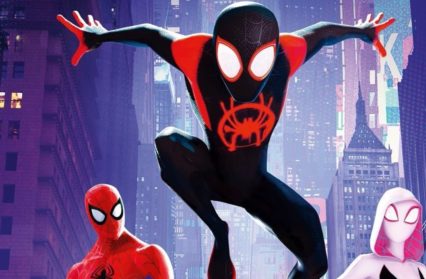Carolyn Percy asks if the animated Into the Spider-Verse is just another cash grab by Sony through using the Spider-Man brand name.

“Not another Spider-Man film!” is what some of you might have thought when SONY announced Spider-Man: Into the Spider-Verse. After two attempts at the franchise, Marvel has helped SONY bring Spider-Man back on track with last year’s Homecoming, will anything they do with Spider-Man that’s not in conjunction with the MCU just be a rehashing of what’s come before, only not as good? Not necessarily. The overwhelmingly positive response to Marvel’s Spider-Man, the recent Playstation4 release, has proved that SONY can do the wall-crawler justice if they put their mind to it and if they have the right people involved.
If you haven’t been following the film’s development, been exposed to any of the reviews (from both critics and audiences) or seen it yet, there are two reasons why it’s worth giving Spider-Man: Into the Spider-Verse ago. Firstly, it’s animated (with animation so gorgeous it’s almost worth the price of admission alone, but more on that in a moment), so there’s a lot more scope for imagination and creativity beyond what live-action can achieve even with the help of CG.
Secondly, whilst this may be an origin story, it’s not a rehash of the Peter Parker story (the film itself even lampshades this, twice). Instead, we follow Miles Morales (who originally appeared in Marvel’s Ultimate continuity and has made some recent appearances outside comics in their game and cartoon releases), a teenager from Brooklyn who, after gaining powers from being bitten by a strange spider, and the death of Peter Parker, must not only learn how to be Spider-Man but stop the Kingpin from enacting a scheme that will endanger the very fabric of reality. Fortunately, Miles might not be as alone as he first thought.
First, let’s discuss the animation. Though “like a comic book come to life” is an epithet that has been applied before, this is definitely true of Spider-Verse: the images, if you look closely, are composed of dots, imitating the old-fashioned Ben-Day dots that used to make up the images in comics; other comic book features, such as thought captions, are used and played with frequently. The film even necessitated the creation of new computer animation programmes: the smooth, graceful motion that is typical of most CG features is achieved by animating at 1s, meaning that the computer puts in one pose for every frame of the film; Spider-Verse is mostly animated at 2s, or, 2 poses for every frame of film, which is much more reminiscent of older animation styles, creating a snappier, more graphic feel. The end result of which does feel remarkable like watching a living, breathing piece of pop art.
But, no matter how good looking a film is, it still needs a good story to back it up. Thankfully, Spider-Verse has one. Written and produced by Phil Lord and Christopher Miller, the people behind films such as The LEGO Movie and The LEGO Batman Movie, the story takes its basic idea – multiple iterations of Spider-Man teaming up – from Marvel’s “Spider-Verse” crossover comic event, and, like those aforementioned films, Spider-Verse is a love letter to the source material. There are lots of great gags, in-jokes and Easter eggs, but there’s also a huge amount of warmth as this is a film where family underpins everything, including the motive of the villain, adding an element of tragedy and making Kingpin a much more complex and interesting villain and ultimately more threatening because of it. (Spider-Verse was also one of the last projects Stan Lee worked on, giving his cameo an extra poignancy.)
So far, Spider-Man: Into the Spider-Verse has been called one of the best films of 2018, the best-animated film of 2018 and has just been announced as a nominee in BAFTA’s Best Animated Film category. Worth all the hype? The only to find out is to go and see it for yourself. (And be sure to stay for the end credits, not just for the now almost inevitable post-credits scene – although this one is a good ‘un – and moving dedication to Stan Lee and Steve Ditko who both passed away last year and without whom we wouldn’t have Spider-Man at all.)
Into the Spider-Verse is available through a variety of online platforms now.
Carolyn Percy is a regular contributor to Wales Arts Review.











